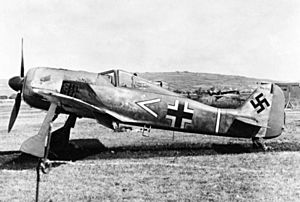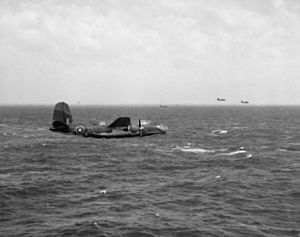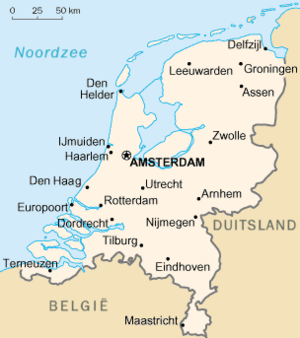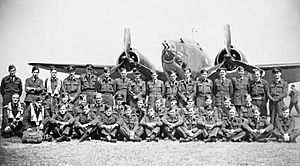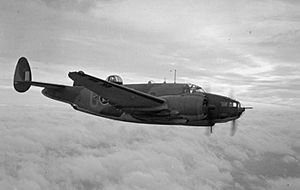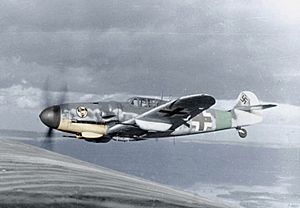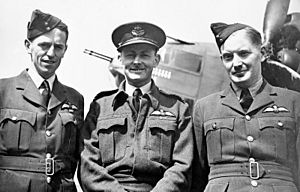Operation Ramrod 16 facts for kids
Quick facts for kids Ramrod 16 |
|||||||
|---|---|---|---|---|---|---|---|
| Part of The Second World War | |||||||
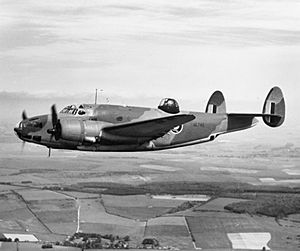 An RAF Lockheed Ventura |
|||||||
|
|||||||
| Belligerents | |||||||
| Commanders and leaders | |||||||
| Strength | |||||||
| 5 Spitfire squadrons 7 Boston IIIA 12 Lockheed Ventura bombers |
70 fighter aircraft | ||||||
| Casualties and losses | |||||||
| 10 Venturas lost near the target, one written off 28 aircrew killed, 12 PoW 1 Spitfire lost; pilot killed |
1 Bf 109, 3 Fw 190s | ||||||
Ramrod 16 was a daring mission by the Royal Air Force (RAF) during World War II. On 3 May 1943, British and New Zealand bomber crews tried to hit important German targets in the Netherlands. The main goal was to bomb the steelworks at IJmuiden. Another group of bombers aimed for the Hemweg power station in Amsterdam. This mission was called a "Ramrod" because it was meant to make German fighter planes come out and fight. British fighter planes would then try to shoot them down.
The plan was complex. Many Spitfire fighter planes were sent to protect the bombers. Some Spitfires flew as a distraction, far from the main target. Others flew close to the bombers, acting as bodyguards. High-flying Spitfires waited nearby, ready to help if needed.
The raid started in the late afternoon. But things quickly went wrong. The distraction planes arrived too early, warning the Germans. The main bomber group, flying Ventura planes, got ahead of their escorts. They ran into many more German fighters than expected. Almost all the Venturas were shot down before they could drop their bombs. One Ventura, flown by Squadron Leader Leonard Trent, managed to shoot down a German fighter. He dropped his bombs, but his plane was hit moments later.
Even though many planes were lost, the bravery of the crews was remembered. Squadron Leader Trent was later awarded the Victoria Cross, a very high honor. His navigator, Vivian Phillips, also received a special medal.
Contents
Why This Mission Was Planned
Early Air Battles
In the early days of World War II, the RAF tried bombing German ships during the day. But this was very dangerous. Many planes were shot down by German fighters and anti-aircraft guns. For example, in December 1939, 22 British bombers faced about 100 German fighters. Eleven British planes were shot down. This showed that flying bombers in tight groups during the day was not safe.
Because of these heavy losses, the RAF changed its tactics. From 1940, most bombers started flying at night. This made it harder for German fighters to find them. However, some special bomber groups, like 2 Group, still flew day missions.
Fighting Over France
After winning the Battle of Britain in 1940, the RAF's Fighter Command started sending planes over France, Belgium, and the Netherlands. This was to challenge the German air force, the Luftwaffe. They used different types of missions:
- Rhubarbs: Two or three fighters would attack small targets on the ground.
- Rodeos: Fighter planes would sweep over enemy territory without bombers. The goal was to make German fighters come out and fight.
- Circuses: A small number of bombers, protected by many fighters, would attack targets.
- Ramrods: Bomber missions with strong fighter escorts. The main goal was to destroy a target on the ground. But the escorts also hoped to shoot down German fighters.
These missions aimed to keep German fighters busy in Western Europe. This would stop them from being sent to other battlefronts, like the Eastern Front against the Soviet Union. However, these missions were often very costly for the RAF. Many British pilots and planes were lost.
By 1942, the Germans had a new, very powerful fighter plane called the Focke-Wulf Fw 190. This plane was better than the British Spitfire Mk V, which most RAF squadrons had. This made day missions even more dangerous. Despite the risks, the RAF continued these operations. They wanted to keep the Fw 190 units tied down in the west.
Planning the Attack
Recent Bomber Missions
Before Ramrod 16, other British bomber groups had been active. In March 1943, 2 Group started using new Douglas Boston bombers. On 1 May, 107 Squadron attacked a target in France, but clouds stopped them. The next day, 107 Squadron attacked the steelworks at IJmuiden. They missed the main works but hit other buildings and ships.
Another group, 464 Squadron, also attacked the steelworks. Their Ventura bombers flew very low over the North Sea. Then they climbed fast to bombing height. They hit parts of the steelworks and sank two ships. On their way back, German Fw 190s attacked them. Two bombers were damaged.
The Ramrod 16 Plan
Ramrod 16 was another attempt to hit the IJmuiden steelworks. Six Boston bombers would attack the steelworks. A diversion was planned using twelve Ventura bombers from 487 Squadron. They would attack the Hemweg power station in Amsterdam.
The crews of 487 Squadron were told about the mission at their base in Norfolk, England. The weather was bright and sunny. They were told to expect strong German resistance. But they had to press on no matter what. Squadron Leader Leonard Trent led the first group of Venturas.
The Venturas were supposed to meet their Spitfire escorts over RAF Coltishall. They would fly low over the North Sea to avoid German radar. Then, ten minutes from the Dutch coast, they would climb quickly to 10,000 feet. This was to surprise the enemy.
The plan also included many fighter squadrons to protect the bombers:
- Target Support: Spitfire Mk IXs would sweep the coast.
- Diversion: Thirteen fighter squadrons would fly a "Rodeo" mission towards Vlissingen, far to the south-west. This was to draw German fighters away.
- Close Escort: Three Spitfire squadrons would fly right next to the Venturas.
- Rear Cover: Three more Spitfire squadrons would wait off the coast. They would protect the bombers on their way home. Mustang fighters would cover the Bostons' return.
The Raid Unfolds
The twelve Venturas took off from RAF Methwold at 4:43 p.m. One plane had to turn back because of a problem. The remaining eleven Venturas met their Spitfire escorts. The Bostons also took off, flying much lower.
The diversion plan went wrong. The thirteen fighter squadrons flying "Rodeo 212" arrived 30 minutes too early. They appeared on German radar, alerting German fighter units.
By chance, many German fighter pilots were already in the Netherlands. They were there for a meeting near Amsterdam. This meant there were many more experienced German fighters ready to intercept the British planes.
The six Boston bombers attacked the IJmuiden steelworks. The first three hit switch and transformer stations. German fighters attacked them as they left, but the Bostons escaped. The second group hit the steelworks. One Boston was shot down in flames.
The eleven Venturas started climbing at 5:35 p.m. just before reaching the Dutch coast. But one Spitfire squadron fell behind. When the bombers reached 12,000 feet, the target was clear to see. German fighters were already taking off. They were ordered to intercept the British planes. About 24 Fw 190s and 8 Bf 109s were sent up.
Over the coast, more than 20 German fighters attacked the Spitfire escorts. Thirty more headed straight for the Venturas. The Spitfires of 504 Squadron were still climbing when Fw 190s attacked them. This cut them off from the Venturas. The leader of the Spitfire wing, Howard Blatchford, tried to warn the bombers. But it was too late. The Venturas were surrounded.
One of the first Venturas hit was flown by Duffill. His plane caught fire, and his gunners were badly hurt. He turned back, followed by two other Venturas, which were quickly shot down. Duffill managed to fly his damaged plane all the way back to England. The gunners were taken to the hospital, and the crew received medals.
Within minutes of crossing the coast, only five Venturas were left. Flying Officer O. E. Foster was the pilot of one of these. He saw the two Venturas in front of him explode. Moments later, his own plane was hit. He turned for home, but his plane was hit again by anti-aircraft fire. The nose of his plane blew off. His navigator was badly wounded, and his rear gunner died. Foster tried to land in a harbor but found himself in the middle of a German convoy. He managed to get away, but his plane was badly damaged and leaking fuel. He crashed into the sea. Foster, his navigator, and the wireless operator managed to escape the sinking plane. They were picked up by a German patrol boat a few hours later.
The last four Venturas faced heavy anti-aircraft fire and more German fighters. One German fighter flew right in front of Squadron Leader Trent's plane. Trent fired his nose guns and saw the German plane go down in flames. Trent was surprised the German pilots kept attacking through such heavy anti-aircraft fire.
As Trent approached the target, he saw his wingman shot down, then the other two planes. He pressed on, dropped his bombs, and turned for home. But his plane was hit again. It went into a spin and broke apart. Trent and his navigator, Vivian Phillips, were thrown out and managed to open their parachutes. The other two crew members died. Trent and Phillips were captured.
In total, ten Venturas were lost near the target. One was damaged beyond repair. Twenty-eight aircrew were killed, and twelve became prisoners of war. One Spitfire was also lost, and its pilot was killed. The Germans lost one Bf 109 and three Fw 190s.
After the Raid
Heavy Losses and Recovery
The loss of so many planes and crew deeply affected the Ventura squadrons. The 487 Squadron diarist wrote about the "bleak day" and the loss of so many good men. One wounded air gunner, Flight Sergeant Urlich, was pushed out of his burning plane by his pilot and navigator, who were then killed when the bomber exploded. Urlich later described the terrifying attack by German fighters.
Despite the heavy losses, 487 Squadron was rebuilt. Squadron Leader Alan Wilson took command. By the end of May, the squadron was back in action. Later that year, they were given faster and more powerful Mosquito planes.
Leonard Trent's Story
After being captured, Leonard Trent became a prisoner of war. He was held at Stalag Luft III, a German prison camp. He took part in the famous "Great Escape" in March 1944. Trent helped hide the sand dug from the escape tunnel. He also worked as a security officer to keep the Germans from finding out. During the escape, Trent made it through the tunnel. But a guard discovered the men waiting to crawl into the woods. Trent was recaptured.
Trent was sent back to England in 1945. He then shared the full story of the Ramrod 16 raid. For his incredible bravery on the mission, Trent was awarded the Victoria Cross on 12 April 1946. His navigator, Vivian Phillips, received the Distinguished Service Order (DSO). Trent continued his career in the RAF, eventually becoming a Group Captain.
Planes and Squadrons Involved
487 Squadron (Venturas)
- AJ209 V: Squadron Leader L. H. Trent's plane. Crashed near Fokker Works. Two killed, two taken prisoner.
- AE916 C: Returned damaged.
- AE731 O: Emergency landing. Three crew killed, one prisoner.
- AE684 B: Shot down. One killed, three prisoners.
- AJ200 G: Shot down. No survivors.
- AE780 S: Shot down. Three killed, one prisoner.
- AE716 U: Crashed. No survivors.
- AE713 T: Crashed. No survivors.
- AJ478 A: Ditched off coast. One killed, three prisoners.
- AE956 H: Lost at sea. No survivors.
- AE798 D: Lost at sea. No survivors.
- Q Queenie: Turned back due to fault. Crew survived.
107 Squadron (Bostons)
- Six Boston IIIA bombers.
Rodeo 212 (Diversion)
- Thirteen 11 Group fighter squadrons flying a diversion to Vlissingen.
Target Support (Spitfires)
- 122 Squadron (5 × Spitfire Mk IX)
- No. 453 Squadron RAAF (11 × Spitfire Mk IX)
Close Escort (Spitfires)
- 118 Squadron (12 × Spitfire Mk V)
- 167 Squadron (8 × Spitfire Mk Vb, 4 × Spitfire Vc)
- 504 (County of Nottingham) Squadron (3 × Spitfire Mk Vb, 9 × Spitfire MkVc)
Rear Cover (Spitfires and Mustangs)
- 302 (Polish) Squadron (7 × Spitfire Mk V)
- 306 (Polish) Squadron (12 × Spitfire Mk V)
- 308 (Polish) Squadron (11 × Spitfire Mk V)
- 613 (City of Manchester) Squadron (8 × Mustang Mk I)
Images for kids


